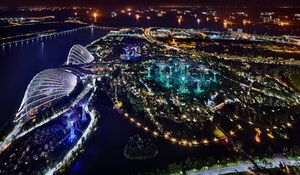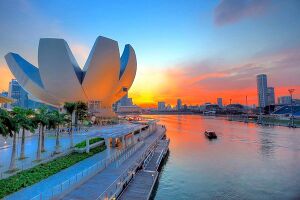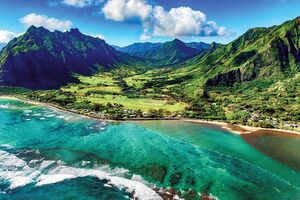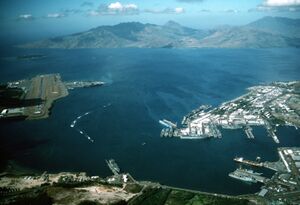User:Apuni
The Dominion of Apuni Apuni | |
|---|---|
|
Flag | |
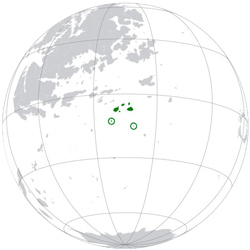 Map of Apuni | |
| Capital | Kailua |
| Official languages | Apunian, Anglish |
| Recognised national languages | Oharic |
| Recognised regional languages | Islandese |
| Ethnic groups | Apuni (Haole/Polynesian) (51%), Oriental (19%), Haole (18%), Other (12%) |
| Demonym(s) | Apunian |
| Government | Republic |
• Chief Executive | Mr. Manapua Kanahe |
| Legislature | Bi-cameral Congress |
| Hui Nui; One representative elected per geographical district | |
| Hui Kanaka; One representative elected based on population density | |
| Population | |
• Estimate | 14,710,000 |
| Currency | Shells (SHL) |
This article is incomplete because it is pending further input from participants, or it is a work-in-progress by one author. Please comment on this article's talk page to share your input, comments and questions. Note: To contribute to this article, you may need to seek help from the author(s) of this page. |
The Dominion of Apuni, otherwise known simply as Apuni is a country on Eurth. Located at the leeward / eastern end of the Southern Metrolas, south east of Pahu Bay, and north of the Safijerian Sea, placing it south of the Eurth equator. The Apunian Island chain encompasses four major and two minor islands in the volcanic island arc and includes numerous small oceanic islands and islets.
The Dominion has a population of approximately 14 million citizens, heavily urbanized in its population centers, but has large expanses protected tropical forests preserves. The population is largely concentrated in major cities located on each island. The total area of the Dominion is 222,780 square kilometers (139,238 square miles).
The Dominion is a newly inducted member of the Entante of Oriental States (EOS).
Geography
Apuni is an archipelago located in the southern Metrolan Sea, consisting of 37 islands, with six main islands being the most significant. These islands are characterized by their volcanic origins, resulting in diverse landscapes that include lush rainforests, rugged mountains, and pristine beaches. The geography of Apuni is marked by its unique topography, which influences the climate and ecosystems found across the islands. The eight primary islands— Punalu’u (the Big Island), Waimanalo, Mokulau, Kapiolani, Aik, Awa and Pele Mauna—each possess distinct geographical features. The Big Island is home to Mauna Naalehu and Mauna Miloli'i, two of the world's tallest volcanoes, while Mokulau is known for its dramatic cliffs and valleys. Waimanalo, the most populous island, features a mix of urban areas and natural landscapes, including the famous Emerald Bowl crater. The surrounding waters of the Southern Metrolas and the Safijeran Sea play a crucial role in shaping Apuni’s geography, providing rich marine biodiversity and influencing weather patterns. The islands are situated at the farthest end of the Metrolan island chain, contributing to the development of unique flora and fauna, further enhancing the islands' geographical significance.
Climate
The climate of Apuni is characterized by its tropical nature, with warm temperature and sunshine throughout the year. Its average daytime temperatures range from the mid 70's to the mid 80's, with cooler evenings. The islands experience two main seasons: a dry season from May to October, and a wet season from November to April, during which rainfall is more frequent, particularly between mountainous regions. Apuni's weather is influenced by it's geographical diversity, resulting in microclimates across the islands. Coastal areas generally enjoy pleasant conditions, while higher elevations can be significantly cooler and wetter. Trade winds play a crucial role in moderating temperatures and providing a refreshing breeze, making Apuni a desirable destination for outdoor activities year round.
The best time to visit Apuni is generally during the dry season (from April through November). However, visitors should be prepared for the occasional rain showers, particularly in the winter months, but the typically pass quickly, allowing for sunshine.
Major Island and Cities
Waimanalo
Kailua (Capital of the Dominion)
Kailua is the capital city of the Dominion of Apuni, as well as being its center of government, major banking sector, and social nexus for the Dominion. Nestled on the southwestern corner of Waimanalu, it is know for its amazing beaches with crystal clear water, including the legendary Naha beach, where golden sands are massaged by the azure waters of the Southern Metrolas. Kailua is also world-renowned as a “green city”, using a combination of traditional preservation methods in conjunction with modern technology to minimize its impact on the local environment. The capital is also know for its historical landmarks such as the Pomaikai’i Mansion (the Chief Executive’s residence), the Pau Mauka National War Memorial (where brave Apunians defended the city during the first Apuni-Lahui war).
Pokai (Gambling and tourism center)
.
Paia (Expanded tourist enclave)
Located on the southern coast of Waimanalo, Paia has extensive resorts and hotels to accommodate the influx of tourist from Eurth.
Mokulau
Primary City: Nanaluki
Nanaluki is known for its exteremly high end entertainment and tourist industry.
Kaha
An "accidental" banking hub, Kaha has been a focus of international banking, a reservoir for "off-shore" accounts, and very discrete financial services.
Kapiolani
Primary City: Pahoa
Pahoa has often been called the "Military's hub", due to the extensive military nautial ports, aerodromes, and support services (including military contractors).
Kapa'a
Kuloa
..
Punalu'u (The "Big" Island)
Primary City: Ha'ena
Ka'ena
Waikapu
.
Aki
Primary City: Malaekahana
.
Awa Palekana
One of the two most distant islands under Dominion control the Awa Palekana ("Safe Harbor"), is a Dominion military facility used for nautical serarch and rescue, escort, and anti-piracy operations in the Southern Meterolas and Safijerian Sea. Due to drug interdiction, human trafficking, smuggling, and piracy problems, the Territorial Navy provides two services to mercantile entities, convoy escorts through the Safijerian Sea to Marenesia, Marenesia Minor, and the Nusaetara Island Chain, and pro-active piracy neutralization ("pirate hunting"). Due to endemic poverty in the numerous island chains of the Safijerian Sea, high-seas piracy of merchant vessels has become a lucrative market. The Dominion Deep Navy works diligently with other political partners to counter this international problem.
Pele Mauna - Volcanic Island Chain
(WIP)
.
..
History
The Dominion of Apuni is a relatively new political entity, establishing its independence approximately sixty years ago. Originally a very loose confederation of small independent cities-states and suzerains, it was infamous as a haven for piracy for decades. Over time, and with the modernization of Eurth navies, piracy in the local island chain abated and the Apuni island chain devolved into an economic vassal of neighboring states. Seizing upon shifting political fortunes during the late 1930s, the islands to consolidated into the current Dominion. Although the Apuni have faced numerous challenges to its sovereignty, it is a small but emerging nation on Eurth.
Pre 1900 history of the Apunian chain
Initially, the tail end of the Metrolan island chain existed at a relatively primitive tribal / substance level existence, with the early Kingdom of Bainbridge Island excursions into the area for trading (and raiding) of natural resources, goods, and workers / slaves. The early settlements were regularly plundered by raiding KBI “Treasure Fleets”, often pitting smaller local entities against each other in order to extract resources. Overtime, the Apuni island chain evolved into a hot bed of piracy, with raiding parties often financed by off-shore entities (often from the KBI), attacking independent traders from the trailing island attempting to make their way from the islands.
1900 – 1920: The Gathering Clouds
This equation continued from the mid 1860’s during the KBI’s “Expansion Era”, through the beginning of the 1900s, where the Island kingdom began retrenching itself due to ongoing social and financial issues. The CEO of Waiwaolani LLC, Mr. Jon Apo, began to notice disturbing trends in the shifting Lahuian economy and social structure. A polymath with extraordinary economic and mathematical skills, he projected the social structure of the Kingdom to breakdown by the mid-1920s, leading to a civil war within the kingdom. To avoid this potential devastation from affecting his economic fortunes, he decided upon a unique plan to save his company, workers, and family. In 1906, he negotiated an agreement with the KBI and the leaders of the city-state of Kaliua to move the majority of his industrial base and business interests to the “remote” island of Waimanalo, under the pretext of expanding KBI influence and use the island as a Royal outpost to enrich the KBI. In actuality, his plan was to keep his industrial, business, and financial interests safe from his predicted economic and social turbulence. Under the pretext of representing the KBI, from 1906 through 1918, he and numerous other trusted financial, industrial, and corporate enterprises relocated to Kailua.
1920 - 1930
1928 – 1930: The Main Island
Having re-established Waiwaolani (WWL) corporation on Kailua, Mr. Apo insisted the main island of Waimanalo be a secure haven for business and shipping interests controlled by the consortium of émigré corporate interests. He contacted other city-states on Waimanolo and offering financial, developmental, and economic assistance in exchange for secure passage of goods to Kailua. Most accepted, with the noted exception of Kaimuki, on the far leeward side of the island. After two rejected offers to join what was beginning to be called the KBI “Dominion”, documents involving allegations of corruption were “exposed”, and the opposition party to the Kaimuki city counsel were placed in-charge of the city-state, with elements of the resistance subdued using the Royal Expeditionary Guards (REG).
1930 – 1933: Reaching Leeward
The Dominion contacted the “Counsel of Equals” in the pirate stronghold of Nanaluki, on the leeward (eastern) island of Mokulau to join with the newly established Dominion. After intense negotiations, an agreement was reached, with the “Mosquito Fleet” of Mokulau providing security for shipping and merchants. Additionally, the “Bug fleet” would have their ships upgraded with newer seafaring technology from the Dominion, allowing them to be come a more effective naval force. The new fleet would also have free reign with letters of marque to engage in “extra-territorial acquisition of resources” from “enemies of the Dominion”.
The next island approached was Malu, a mineral-rich southern island which suffered from a lack of economic development due to local politics. The Dominion approached each of the leaders of the three major city-states with offers to ensure safe passage of their goods using the protection of the Dominion Fleet to develop their natural resources, and improve the over lively hood of the Malu if they joined the Dominion. The offer of dramatically improving their standard of living and exert control over the island was an irresistible offer, which two of the three city-states accepted and joined the Dominion. The last city, Kamana, refused the offer and fought a losing battle against Dominion expansion. Ultimately, a siege and blockade of Kamana led to capitulation of the city and integration into the Dominion.
1934 – 1935: The Big Island Campaign
With the leeward islands joining the Dominion, the last major holdout island was Kapiolani, to the west of Waimanalo. This island’s city-states were known for their ferocious warriors and was viewed as the final challenge to integrate into the Dominion. Of the five city-states on the island, the Pahoa were best known to the Dominion due to their close physical location and ties to the capital Apunian city of Kaiula. When offered to join the Dominion, the Pahoa accepted, and agreed to use their city and resources as a launching point towards adding the the westward island to the Dominion. After a long and bloody series of land battles, the city-state of Ali Wai surrendered after a well-coordinated landing by the newly re-branded Dominion Marine Expeditionary Force (precursors to the Dominion Marines). The city expected to be decimated and enslaved upon capitulation, but the defeated were offered a chance to join the Dominion. A shocked and grateful city accepted, and with the Pahoa, worked to subjugate two of the other four city-states (the Makapu’u and the Lanakoi), with the last hold out city-state surrendering after a two-week seige. Finally, the lightly populated island of Aki was quickly integrated, completing the consolidation of the Dominion, as of August 1st, 1935.
1936 – 1946: The Compact
The following years were marked with establishing economic standards and social norms within the Dominion. Economic development was enhanced with minimal involvement from the Dominion government. The island of Malu had its first shipyard built, expanded its mining industries, and rapidly became a hub of engineering and architectural innovation.
Socially, the Dominion was working towards establishing a common culture. Compensatory and free primary and secondary schools were established for children through age sixteen, in an effort to develop an educated populace (and workforce). Establishments of higher learning were also built, including the University of Kailua and Makaha Institute of Technology on Waimanalo, the Nanaluki Economic University on Molakau, and the Technical Institute of Malu. Entrance to these institutes (and other colleges) was determined by the “Hoao Nui” (Great Test), given once annually to all eligible students. Military education was formalized through service academies, and a new command and control center built southern side of Pahoa peninsula, known as the “Quad” (om its square shape). The Dominion Civil Guard, Air Corps, Navy, and the Marines have their academies located on Kaipiolani, along with separate training facilities.
The Dominion military quickly professionalized its military to match modern warfare practices. After visits to other national entities to see observe how other nations operated their services, best practices were studied, and subsequently implemented into the Apunian military forces. The Dominion Navy and Marines formalized their rank structure, strategic and tactical guidance, and infrastructure practices to provide better security to the Dominion.
An economic emphasis was placed on developing a strong and efficient capitalist practices through the chain. Although some financing debt was incurred during the consolidation of the islands, this debt was quickly paid off through negotiations and in-kind trade, including ores, spices, tobacco, and other developing natural resources. Additionally, efforts to encourage entrepreneurship and develop small business was at the forefront of the government economic policy.
1949 – 1951: The Return of the Empire
Official contact between the Kingdom of the Bainbridge Islands and the Apuni was re-established at the behest of King Kamehameha VII in 1948. Apunian Diplomatic corps representatives were sent to the Iolani Royal Palace in Honolulu in 1949, where the Dominion were thanked for being loyal subjects of the Kingdom and expanding their influence on the trailing island chain. However, they were required to re-pledge their loyalty as subjects to the Kingdom and re-integrate into the Lahui realm. The Dominion representatives informed the king this was impossible, as the Dominion was now an independent entity. The king stated this response was not satisfactory, and informed the representatives to inform the Dominion counsel they had six months to reconsider their heretical statement, apologizes for their arrogance, subject themselves to his Majesty’s punishment, and provide a substantial “penance” of 100 million shells in gold for their impudence. If not, they would be forcefully re-integrated into the Kingdom. After six months with no response, the KBI Royal Navy was dispatched to re-integrate the upstart Dominion into the Kingdom of the Bainbridge Islands.
1952: 1st Lahui / Apuni War
Early February of 1952 saw the arrival of the Royal Bainbridge Island Navy pass Mist Island and into the Mokuahuana Channel, entering Dominion waters. Known as the “Silver Fleet” due to the excessive brilliance shown from the ships, the idea was they could display a show of force and intimidate the Dominion into submission. However, the was a significant lack of intelligence regarding the Apunian military by the KBI. The original intelligence provided to the Royal Diplomatic Service indicated the Apunians were significantly behind the KBI technologically, and minimal effort would be required to ensure their re-joining the Kingdom. However, this lack of intelligence, miscommunication, and hubris ultimately led to the defeat of the KBI during the first war between the nations.
Once the KBI entered crossed the Mokuahuana Channel, they decided on a two-pronged approach towards addressing the “rebellion” issue. The main elements of the Silver Fleet would head south to Waimanalo, deliver an ultimatum, and if Kailua did not capitulate, the capital city would be bombarded into submission, followed by landing and subjugation a KBI expeditionary marine force. The second branch of the Silver Fleet, led by Royal Admiral Haana would eradicate any non-friendly nautical forces (essentially anyone not flying a KBI flag was considered an enemy and would be attacked up on a negative identification). Once major elements were removed from the area, Nanaluki would be provided the same opportunity to surrender or be bombarded into submission.
The Kailua Bay Turkey Shoot
The main element of the Silver Fleet encountered only minor resistance en route to Kailua. With the exception of some antiquated ships loaded with explosives sent as “fire ships” (which were easily dispatched by escorts), the arrival of the HMS King Kamehameha I in the Bay of Kailua was inconsequential. Upon anchoring in Kailua bay, the royal letter of demand was delivered and subsequently rejected out of hand. Within one hour of the rejection, the King Kam began bombardment of outlying areas surrounding Kailua, under the theory of preserving wealth and resources to bring back to Honolulu. Within fifteen minutes of the beginning of the bombardment, three squadrons of retrofitted Astrini fighters established tactical air superiority over the Silver Fleet, dive-bombing the thirty-three ships of the main flotilla, sinking nineteen (including the King Kamehameha), and completely incapacitating six. Of the remaining eight ships, three were destroyed while escaping to the international waters in Mokuahana Channel, with the remaining five reaching the KBI Royal Naval base on Mist Island. Although the Apunian Naval Air Corps suffered significant losses during the bombardment, they were able to successfully destroy the majority of the Silver Fleet and drive it from Apunian territorial waters.
The Mosquito Fleet Bites
The secondary force of the Silver Fleet worked its way to Mokulau, also known by the KBI as Outcast Island. A purported den of piracy, the purpose of this offshoot from the Silver Fleet was purportedly the same – attempt to intimidate the locals in Nanaluki into surrendering, and failing that, bombard the city into submission. However, the Silver Fleet task force was unaware of the newest naval development of the Dominion Navy – the Patrol Torpedo Boat (PTB). Knowing they could not match the strength of the Royal Navy, the Dominion decided to subject the KBI to a proverbial “death of a thousand cuts”. Since the PTB had quicker speeds than the Silver Fleet offshoot, the “Mosquito fleet” was able to inflict continual damage to the Task Force, first sinking its slower support ships, then attacking the larger vessels. This strategy limited the already damaged Task Force ships from completing the needed repairs to the complete their mission. Overall, the Mosquito Fleet was able to sink eleven of the sixteen ships of the KBI Force, suffering only twenty-seven PTB losses. With no support ships and dwindling expenditure of oil, the remaining Silver Fleet Task force retreated to international waters in the Strait. During the retreat, they lost an additional five ships, with a sixth sunk in the Channel.
The Revenge of the Dominion
With the Silver Fleet decimated as a fighting force, the Dominion Navy went on its offensive. Crossing the channel, the Dominion First Strike Group sent two destroyers, the Apuni Dominion Ship (ADS) Undaunted and the ADS Vindictive to bombard the outskirts of the RBI city of He’e. This venture was a decoy to draw the larger force of the Royal Navy to the open seas, south of the Lapaki Channel and away from the range of the Royal Air Force. As the two ADS destroyers returned to the main fleet, KBI naval ships raced to intercept them to claim victory and (bragging rights) for each ship’s captain. The decoy attack by the Dominion Navy led KBI ships piecemeal piecemeal to a main Dominion Strike group which effected a “Retreating Attack”, eliminating approximately twenty-two ships before the force was recalled to Pearl Harbor. Having inflicted significant damage to the KBI Navy, the Dominion Strike Force retreated to Dominion waters for repairs and refueling.
The Long Drum Roll
With almost sixty percent of the KBI naval forces destroyed due to the Silver Fleet’s defeat and the subsequent counter attack by the Dominion, limited the Royal Fleet’s ability to maintain control over its island provinces. Additionally, the threat of a second attack by the Dominion Navy led the KBI to call to sue for a cease-fire. The Orthen Accords were brokered by the Europan Commercial Alliance, the precursor of the Entente of Oriental (EOS) states. These accords were signed by both parties and led to a cessation of hostilities, but did not establish a permanent peace. Both sides were too weak to impose their will on the other, as the KBI still considered the Dominion a rogue province and the Dominion still seeking recognition as an independent entity. Thus, a cease-fire was established with the two nations still technically at war.
1952 – 1960 – Post-War Recovery
1961 – 1976 – The Economic “Sunrise”
1977 – 1988 – The Koi era (economic boom)
1989 – 1990 – The “Quiet Conflict” (Second Lahui/Apuni conflict and Economic Rescission)
1991 – 2000 – The second “Sunrise”
2001 – 2012 – The First “Sunset” (Recession)
2013 – Current Day – The “New Horizon”
Governance
(WIP)
The Dominion is a democratic federation, consisting of a legislative, executive, and judicial branches. The Dominion's legislative branch is bi-cameral, consisting of two chambers, the lower chamber known as the "Hui Kanaha" (the People's Assembly) and the upper chamber known as the "Hui Nui" (the "Chiefs' Council").
Legislative Branch
The Hui Kahana is elected based on a proportional representation system. Every five years, each citizen votes on candidates from the competing political parties and the outcome determines the number of junior representatives of each district. The Huk Kahana total representation is adjusted periodically to ensure it remains proportional to the population. The Kahana is responsible for drafting and passing legislation related to national policies, budgets, and other matters which affect the entire nation. They serve a fixed term of four years, staggered for re-election every two years. The Hui Nui is composed of senior representatives who are elected by each of the Dominion's territories (also known as administrative regions), regardless of population. The Nui focuses on maters related to individual territories, including local governance, territorial management, and regional development. They also play a significant role in reviewing and amending legislation proposed by the Hui Kahana.
Executive Branch
The Apunian head of state is the "Chief Executive".
Judicial Branch
The Judicial branch is known as the "Judges' Bench" (or just the "Bench"), which are responsible for interpreting and applying Dominion law. The judiciary is composed of lower courts throughout Apuni.
Politics
(WIP)
The Dominion has six notable political parties, with two primary parties and four minor parties.
The Mercantilist Party
(The centrist-conservative party)
The New Horizon Party
(The centrist-liberal party)
The Sacred Land Party
Otherwise known as the Ecology party, the Kaiola places an emphasis on stewardship of the natural environment of the Dominion.
The Kala Party
Translated as the "money" party, this group focuses mainly on aggressive development of business interests within and outside of the Dominion. This party is well-funded by business interests, but have a somewhat questionable reputation.
The Reformist Party
(The Far-left Party)
The Haipule
(The "religous right" party)
Economy
(WIP)
The Dominion of Apuni currently has a thriving, multi-faceted economy, including:
Industries
Tourism and Gambling
The Dominion's natural beauty, white sand beaches, and vibrant culture have made it a popular tourist destination. The tourism sector complements its lucrative gambling industry by providing jobs and revenue from visitors.
Banking and Financial Services
Apuni has a thriving financial services sector which compliments its stringent banking laws and offshore accounts, contributing to its economic prosperity.
Information Technology
Apuni is known for its cutting-edge technology sector, with a focus on software development, data analytics, and cybersecurity. The Dominion has attracted tech companies, entrepreneurs, and innovators from around the world due to its favorable business environment and talented workforce.
Maritime Trade and Logistics
Situated strategically at the crossroads of major shipping routes, Apuni boasts a busy ports and a well-developed logistics infrastructure. The Dominion is a global hub for trade and servers as a transshipment point for goods travelling between continents, contributing significantly to its economy.
Sustainable Aquatic Agriculture
The Apuni have invested heavily in sustainable aquatic agriculture, specializing in the culvation of seaweed, oysters, and other marine delicacies. Using eco-friendly and responsible farming practices, the island has become a leader in maritime agriculture, supplying both domestic and international markets.
Specialty Agricultural Products
Economic Policies
Low Taxation
Sustainability Initiatives
Infrastructure Development
International Trade Partnerships
Military
(WIP)
As an island chain, the Dominion places a substantial focus on its naval forces. As it's largest armed entity, it consists of disparate branches, each with its own unique focus.
(Provides primary defense for the territorial islands of the Dominion.)
(Works to ensure safe passage for merchant vessels within Dominion seaways and extending to peripheral waterways.)
Ecological Corps
(The branch focused on maintaining ecological security and enforcing ecological regulations and integrity.)
The Dominion Marines
(The ground forces of the Dominion, which focus on jungle & island warfare, including sea-to-shore assaults.)
The Dominion Air Corps
(The aero branch of the Dominion, frequently working in concert with the other two branches of the Dominion military.)
Cultures
(WIP) The ethnicity of Apuni’s population is primarily of Polynesian descent, but with mixed races (Polynesian/Haole (aka Caucasian)/Oriental) comprising approximatly just over 50% of the population. The remaining half of the population is either of Haole (18%), Oriental (17%), or native Polynesian backgrounds (13%).
Although the primary culture is also Polynesian, there are significant influences from Haole and Oriental cultures. Additionally, the democratic and libertarian aspects of their piracy background are evident as part of the Apunian culture. Most Apunians are known to be trade-inclined, enjoy haggling and notoriously thrifty and frugal.
Kingdom of Bainbridge Island (KBI) and Lahui disambiguation
NOTE: The term “Lahui” is the proper Islandese term the natives of the KBI refer to themselves.
Editor NOTE: This is akin to the term “Estados Unidenses” in Spanish when referring to United States citizens. Citizens of the United States do not call themselves “United State-ians”, but use the term “American”. However, Spanish speakers use the term “Estado Unidenses” (“United State-ian”) for citizens of the United States. Likewise, though non-KBI individuals call the kingdom the “Kingdom of the Bainbridge Islands” (in Anglish), the citizens of the KBI call themselves the “Lahui” (“the People”, in Islandese).

